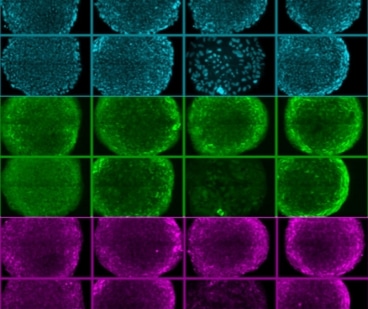Most of the materials used today to grow human stem cells consist of cells or proteins derived from mouse embryos, which, although they help initiate the growth of stem cells, will most likely also cause an immune response after injection into a human patient. At MIT they developed a synthetic substrate

Human stem cells, which are capable of differentiating into all other types of cells, have great potential for the treatment of a variety of diseases, including Parkinson's, multiple sclerosis and spinal cord injuries. However, researchers working with such cells have problems producing large enough quantities of them for conducting experiments - especially, for human experiments. Beyond that, most of the materials used today to grow human stem cells consist of cells or proteins derived from mouse embryos, which, although they help initiate the growth of stem cells, will most likely also cause an immune response after injection into a human patient.
In order to overcome these problems, chemical engineers, materials scientists, and biologists from MIT University developed a synthetic surface that does not include foreign material originating from the human body and allows the stem cells to live and continue to replicate themselves for three months. In addition, this is the first synthetic material that allows single cells to form colonies of identical cells, which are required to characterize cells with desired properties and were problematic to prepare with existing methods.
The research team, led by scientists Robert Langer, Rudolf Jaenisch and Daniel G. Anderson, describes the new material in an article published in the scientific journal Nature Materials.
Human stem cells can come from two sources - embryonic cells or body cells that have been reprogrammed to an immature state. This state, known as pluripotency, allows cells to develop into any unique type of body cell. They also make it possible to treat almost any type of disease that involves damage to cells. For example - researchers will be able to grow new nerve cells for patients with spinal injuries, or insulin-producing cells for patients with type 1 diabetes.
To develop such treatments, researchers will need to be able to grow stem cells in the laboratory for a long period of time, change their genes, and grow colonies of identical cells after the desired genetic change. Existing growth surfaces, which consist of a plastic plate coated with a layer of gelatin and on top of that a layer of mouse cells/proteins, are not effective enough, says the lead researcher.
"For healing purposes you need millions upon millions of cells," explains the researcher. "If we can get the cells to divide more easily, this will greatly aid in obtaining large and sufficient quantities of cells for all the disease studies that scientists are so excited about."
Previous studies hinted that a number of chemical and physical properties of the surfaces - including their roughness, hardness and affinity for water - may play an important role in the ability of stem cells to grow. The researchers prepared about five hundred types of polymers with such variable properties, grew stem cells on them and tested the activity of each and every polymer. After determining the relationship between the properties of the surface and the efficiency of its activity, the researchers found that there is an optimal range of the surface's hydrophobicity (the ability to repel water), along with the result that the roughness and hardness of the surface do not affect the ability of the stem cells to grow. In addition, they also changed the composition of the materials, including adding proteins bound to the polymer. They found that the best polymers contained a high proportion of acrylates - a common component in plastic materials - and those coated with a protein called vitronectin, which encourages cells to stick to surfaces.
Using materials that were of the highest quality, the researchers were able to obtain stem cells (both of embryonic and pluripotent origin) that continued to grow and divide for three months. They were also able to produce large amounts of cells - in the amount of millions.
The researchers from MIT hope to improve the knowledge obtained from their experiments to help build different materials suitable for other types of cells, notes the researcher Anderson from the department of chemical engineering at the university. "We are interested in better understanding the interrelationships between the cell, the surface and the proteins, and to more precisely characterize the factors that influence the growth of the cells," he explains.
